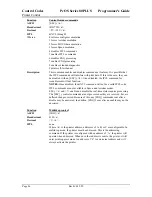
Control Codes
PcOS Series 80PLUS
Programmer's Guide
Graphic Save
Page 40
Rev B 4/13/99
Graphic Save
The PcOS Series 80PLUS Printer contains a graphic save buffer. This buffer is 24K bytes long and
can be saved in the printer’s nonvolatile memory. The nonvolatile memory is read at power up and is
available to be printed with a single command. The purpose of this feature is to allow a graphic logo
to be stored in the printer and printed on command.
The buffer is intended to save a graphic image. However, any print information can be saved and then
reprinted. The print information in this buffer can be replaced at any time and then reprinted. It does
not need to be saved in the nonvolatile memory. It is feasible for the buffer to be used to create a
duplicate receipt.
Programming considerations
This feature works by inserting the save graphic buffer into the printer data stream when the
print graphic save command is encountered.
Some care should be taken when forming this buffer. Because when this buffer is inserted, any
configuration commands (like font or pitch changes) will remain in effect after the buffer is
complete and/or printed.
The nonvolatile memory has a limited number of write-cycle operations. For this reason, the
number of saves should be limited. The buffer should not be saved on a transaction by transaction
basis. Once a day should be the limit.
The buffer is 24K bytes long. All commands
3
and print data are placed in the buffer and both
must be included in the 24K limit. There is no indication by the printer when it is full. The
application must make sure that the buffer is not overfilled. The printer will simply stop saving
information in the buffer after 24K characters are received.
As the buffer is filled, the input data is printed normally. The effect of the graphic save start
command is to start to save the input data. The graphic save stop command stops saving data and
initializes internal pointers for the next print. The graphic save "stop and save" command stops
the save, writes the buffer to the nonvolatile memory, and then initializes the internal pointers for
the next print. The graphic save print command inserts the buffer into the print stream after the
graphic save print command.
3
IPCL commands are converted by the printer into an equivalent [ESC] code and then placed in the save
buffer. The equivalent [ESC] code should be used to calculate the size of the save buffer data.
















































